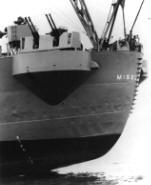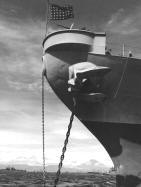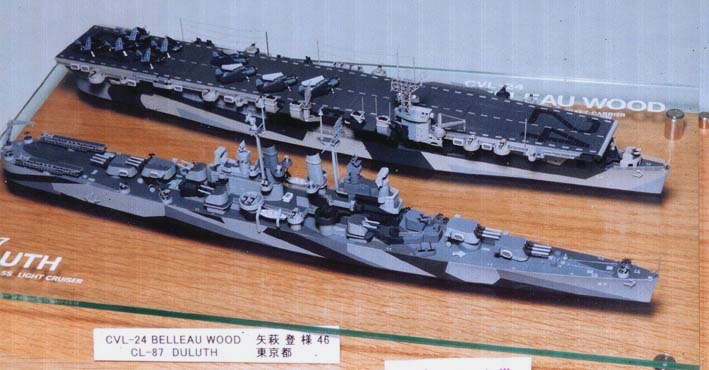|
Toll free 800 - 845-1140 |
|
Shipping
will be added to all orders, we always endeavor to give you the
best rate >>> Click for Rates. |
If you have any
questions or need help email us, call us or click here for HELP

USS Independence Class
Light Carriers CVL's
These two fine models were
built by Nobori Yahagi from steelnavy.com
List Price $52.95-
A120 Our Price $43.95
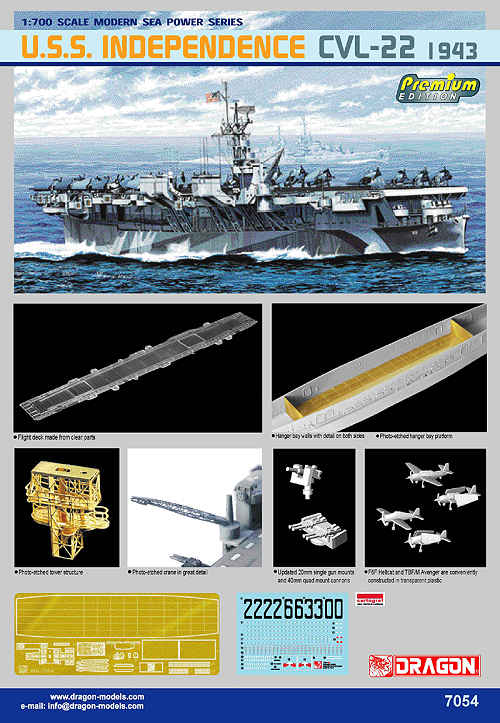 |
These carriers can be built
from
this kit by adding
GMM700-2D
Carrier decal set.
Main
Features:
- New flight deck made from clear parts
- Photo-etched hanger bay platform
- Photo-etched radio tower
- Photo-etched SK radar
- Photo-etched crane in great details
- Updated 20mm single gun mounts and 40mm quad
mount cannons
- F6F Hellcat and TBF/M Avenger constructed in transparent plastic.
- Cartograf decal marking for:
USS
Independence, USS Belleau Woods
USS Cowpens and USS Monterey
USS
Independence
USS Belleau Woods
USS Cowpens
USS Monterey
Kit# A120-121 - $30.95
If you are building these ships
below you need extra decals.
USS Princeton CVL-23
USS Langley CVL-27
USS Cabot CVL-28
USS Bataan CVL-29
USS San Jacinto CVL-30
you'll need decals 6.00 extra |
The Independence class carriers were a result of President Franklin D.
Roosevelt's interest in Navy shipbuilding plans. In August 1941, with war
clearly in prospect, he noted that no new fleet aircraft carriers were expected
before 1944 and proposed to quickly convert some of the many cruisers then
building. Studies of cruiser-size aircraft carriers had shown their serious
limitations, but the crisis following the December 1941
Pearl Harbor disaster demonstrated the urgent need to have more carriers as
soon as possible. The Navy responded by greatly accelerating construction of the
big Essex
class carriers and, in January 1942, reordering a Cleveland class
light cruiser as an aircraft carrier.
Plans developed for this conversion showed much more promise than expected
and two more light cruisers were reordered as carriers in February, three in
March and a final three in June 1942. Completed in January-December 1943,
simultaneously with the first eight Essex Class, the nine Independence
class ships were vital components of the great offensive that tore through the
central and western Pacific from November 1943 through August 1945. Eight of
them participated in the June 1944 Battle of the Philippine Sea, which
effectively eliminated Japan's carrier air power, supplying 40 percent of the
fighters and 36 percent of the torpedo bombers.
The Independence class design featured a relatively short and narrow
flight deck and hangar, with a small island. To compensate for this additional
topside weight, the cruiser hulls were widened amidships by five feet. The
typical air group, originally intended to include nine each of fighters,
scout-bombers and torpedo planes, was soon reoriented to number about two dozen
fighters and nine torpedo planes.
These were limited-capability ships, whose principal virtue was near-term
availability. Their small size made for sea keeping problems and a relatively
high aircraft accident rate. Protection was modest and many munitions had to be
stowed at the hangar level, a factor that contributed greatly to the loss of
Princeton
in October 1944.
There was also little margin for growth, as their post-war careers showed.
Independence was expended as an atomic bomb target, and the rest were
laid up in 1947. Five returned to service in 1948-53, two with the French Navy.
Two were used as training carriers, while
Bataan
saw Korean War combat duty with Marine Corps air groups. She and
Cabot
received anti-submarine warfare modernizations in the early 1950s, emerging with
two smokestacks instead of the original four. All but the French ships
decommissioned in 1954-56 and were reclassified as aircraft transports in 1959.
Cabot got a new lease on life in 1967, when she became the Spanish Navy's
carrier Dedalo, serving until 1989.
The nine ships of the Independence class were all converted from
Cleveland class light cruisers building at the New York Shipbuilding
Corporation shipyard, Camden, New Jersey. Initially classified as "aircraft
carriers" (CV), all were re-designated "small aircraft carriers" (CVL) on 15
July 1943, while four ships were still under construction. Individual ships'
construction data follows:
Independence (CV/CVL-22). Keel laid in May 1941 as Amsterdam
(CL-59); reclassified as an aircraft carrier in January 1942; launched in August
1942; commissioned in January 1943.
Princeton (CV/CVL-23). Keel laid in June 1941 as Tallahassee
(CL-61); reclassified as an aircraft carrier in February 1942; launched in
October 1942; commissioned in February 1943.
Belleau Wood (CV/CVL-24). Keel laid in August 1941 as New Haven
(CL-76); reclassified as an aircraft carrier in February 1942; launched in
December 1942; commissioned in March 1943.
Cowpens (CV/CVL-25). Keel laid in November 1941 as Huntington
(CL-77); reclassified as an aircraft carrier in March 1942; launched in January
1943; commissioned in May 1943.
Monterey (CV/CVL-26). Keel laid in December 1941 as Dayton
(CL-78); reclassified as an aircraft carrier in March 1942; launched in February
1943; commissioned in June 1943.
Langley (CVL-27). Originally planned as Fargo (CL-85);
reclassified as an aircraft carrier in March 1942; keel laid in April 1942; name
changed from Crown Point to Langley in November 1942; launched in
May 1943; commissioned in August 1943.
Cabot (CVL-28). Keel laid in March 1942 as Wilmington (CL-79);
reclassified as an aircraft carrier in June 1942; launched in April 1943;
commissioned in July 1943.
Bataan (CVL-29). Originally planned as Buffalo (CL-99);
reclassified as an aircraft carrier in June 1942; keel laid in August 1942;
launched in August 1943; commissioned in November 1943.
San
Jacinto (CVL-30). Originally planned as Newark (CL-100);
reclassified as an aircraft carrier in June 1942; keel laid in October 1942;
name changed from Reprisal to San Jacinto in January 1943;
launched in September 1943; commissioned in December 1943.
Independence class "as-built" design characteristics:
Displacement: 11,000 tons (standard)
Dimensions: 622' 6" (length overall); 71' 6" (hull); 109' 2" (over flight
deck and projections)
Powerplant: 100,000 horsepower, steam turbines, four propellers, 31.5 knot
maximum speed
Aircraft (Typical operational complement, October 1944): 34 planes,
including 25 F6F fighters and 9 TBM torpedo planes.
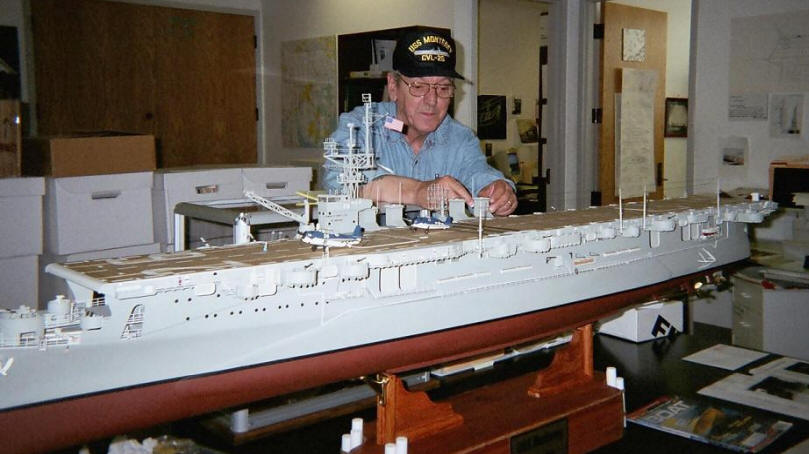 |
The Seaport
Independence Museum of Phil., PA asked master builder Ray Guyette
for a model of the USS Monterey
for the museum he built one 7ft long 100 times larger than our 1/700
scale 10" model and here is his 1/72 scale model. |

